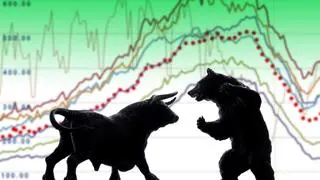The Indian benchmark indices — the Sensex and the Nifty 50 — fell over a per cent during the truncated trading week, weighed by global events. Two major events triggered the sell-off in the markets. Chinese exports tumbled 10 per cent (year-on-year) in September against market expectations of a 3.3 per cent fall.
The fall in exports — the most since February — has raised concerns on the slowing global demand and thus, on the overall growth outlook.
The minutes of the US Federal Reserve’s September meeting released on Wednesday offered little respite for markets. It pointed to a likely rate hike by the end of the year with several members indicating that ‘it would be appropriate to increase the target range for the federal funds rate relatively soon if economic developments unfolded about as the Committee expected’.
Following these events, the Indian markets opened with a huge gap-down on Thursday after remaining closed for two days. They fell 1.5 per cent on a single day. The easing inflation numbers too failed to cheer the domestic markets and global factors continued to dominate. Both the Consumer Price Index (CPI) and the Wholesale Price Index (WPI) inflation fell in September. The CPI fell to 4.3 per cent from 5 per cent in the previous month and the WPI dropped slightly to 3.5 per cent from 3.7 per cent a month earlier.
The second quarter earnings season that started on a sombre note following the results of the IT majors, TCS and Infosys, may keep the market under pressure in the coming week as well.
Nifty 50 (8,583.4)After opening the week on a slightly positive note, the Nifty 50 index fell to close in the red for the week. The index fell 114 points or 1.3 per cent to close just above the crucial support levels.
This week: Since August, the Nifty 50 index has bounced back every time it fell to test 8,540 levels. Last week, the index fell to 8,541 on Thursday but managed to sustain above it on Friday. If it continues to trade above 8,540, a rise to 8,700 and 8,750 once again cannot be ruled out.
But if the index breaks below 8,540, it can dip to 8,520 or 8,500. The 21-week moving average at 8,520 and the 100-day moving average around 8,500 are crucial support levels to watch in the near term. A strong break below 8,500 may strengthen the sell-off in the market. The short-term target below 8,500 is 8,430.
Medium-term view: As has been reiterated in this column, 8,500 is a key support level. A strong break below this level can drag the index lower to 8,200 or 8,150 — the 38.2 per cent Fibonacci retracement support level. Further fall below 8,150 looks less likely at the moment and the index may resume its overall uptrend thereafter.
On the upside, 9,000 is a key resistance a break above which may target 9,100 and 9,300.
Sensex (27,673.6)Sensex fell after gaining slightly in the initial part of the week. The index ended the truncated week 387 points or 1.4 per cent lower.
This week: For the near term, 27,450 is a key support to watch. Though a test of this level cannot be ruled out, only a break below it will increase the likelihood of a further fall. The next target will be 26,950. However, if the index manages to sustain above 27,450 and reverses higher, it can rise to 28,000 and 28,200.
Medium-term view: The level of 26,500 and 26,200 are key medium-term supports which is likely to limit the downside in the index. The outlook will turn bearish only on a strong fall below 26,200. On the upside, 29,000 is a significant resistance which has to be breached for the index to gain fresh momentum. It will then clear the way for the next target of 30,000
Global cuesThe outlook for the Dow Jones Industrial Average remains unclear as the index is stuck inside the narrow 18,000-18,400 range for about a month now. A breakout of this range on either side will decide the next move.
A strong break below 18,000 may drag it down to 17,600. On the other hand a decisive break above 18,400 is needed to boost the bullish momentum. Such a break will take it to 18,650 initially. Further break above 18,650 may target 19,000 levels going forward.
Crude oil prices continue to hover between $49 and $51.6 per barrel for more than a week now.
The broader bias is bullish and the possibility of the oil prices rallying beyond $51.50 in the coming days cannot be ruled out. Such a rally may keep domestic markets under pressure.








Comments
Comments have to be in English, and in full sentences. They cannot be abusive or personal. Please abide by our community guidelines for posting your comments.
We have migrated to a new commenting platform. If you are already a registered user of TheHindu Businessline and logged in, you may continue to engage with our articles. If you do not have an account please register and login to post comments. Users can access their older comments by logging into their accounts on Vuukle.